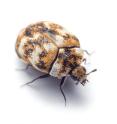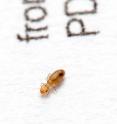Rich bugs revealed: Homes in wealthier neighborhoods host a greater diversity of insects
Related images
(click to enlarge)
Household insects -- our most overlooked roommates -- are grabbing the spotlight after centuries in the shadows. Prior research in the growing study of life indoors has shown that our homes support a variety of bugs in the far reaches of cupboard corners and attic alcoves. Now, researchers are looking beyond the nooks and crannies to consider the socioeconomic context of these households. A team from the California Academy of Sciences, North Carolina State University, and the Natural History Museum of Denmark surveyed the number of different insects in 50 urban homes and determined that wealthier neighborhoods host a greater number of species types than their lower socioeconomic counterparts. The findings are published today in the journal Biology Letters. "The sheer amount of life thriving within your home -- under carpet, in closets -- is astonishing," says Dr. Misha Leong, lead author and post-doctoral researcher at the Academy. "Now we're learning that neighborhood affluence was one of the primary predictors for the number of different bug types -- mostly non-pests -- living inside, which really surprised me. We hope our findings inspire people to reimagine the context of their homes and apartments within the larger environment."
Modern urbanization has greatly influenced the ecological environment, particularly in terms of the variety and abundance of life that surrounds us. Aside from urban variations in climate and environment, this new study points to socioeconomics as a key player in determining the types of life we find inside our concrete jungles. This work suggests that the management of neighborhoods and cities can have effects on biodiversity that extend from trees and birds all the way to the bug life in bedrooms and basements.
The luxury effect
Urban ecologists have been observing how socioeconomics impact species diversity for nearly two decades. Previous studies have determined that higher affluence is frequently associated with more biological diversity across species of plants, birds, bats, and lizards -- a phenomenon coined the "luxury effect." Scientists have only recently begun examining the relationship between socioeconomics and arthropods, a group that includes insects and their close relatives. Arthropods can have six legs (like moths), eight legs (like spiders), or sometimes one hundred legs (like centipedes), and fly or wander from the outside environment into the indoor world.
"The biodiversity of the indoor environment is still a relatively unexplored area of research," says Michelle Trautwein, co-author and curator of entomology at the Academy. "Our houses are really permeable and dynamic. Through our studies, we hope to inspire citizens all over the globe to get curious about the species in their everyday lives. We still have so much to learn about indoor ecology and the ever-evolving relationship between humans and arthropods."
A hands-and-knees investigation
With the help of headlamps and knee pads, the research team surveyed 50 urban homes in Raleigh, North Carolina to collect samples of arthropod species. The specimens, stored in glass vials for safe transport to the lab, were painstakingly identified under a microscope to determine the number of arthropod families represented, indicating overall arthropod diversity in each household.
Besides average neighborhood income, the study took into account such factors as the homes' square footage, size, surrounding vegetation, and more. Houses tend to serve as light and bait traps, passively collecting species that find their way inside from vegetation outside. The study found that homes in higher income neighborhoods had higher arthropod diversity. A likely mechanism is that homes in these neighborhoods host a greater diversity of plants that, in turn, allowed for a greater variety of plant-loving arthropods to find their way inside and thrive indoors.
The scientists found that individual houses without significant plant coverage in the yard could still support high arthropod diversity when located within more affluent neighborhoods. This finding suggests that features such as parks and communal landscaping that are characteristic of wealthier neighborhoods as well as lush landscaping choices of neighbors can compensate for local choices of homeowners.
"Seeing how these community-wide planning decisions cascade through the neighborhood and into homes is fascinating," says Leong. "Besides parks and communal landscaping, the decisions made at the micro-scale of individual property owners collectively scales up. This influences the ecological dynamics within their respective neighborhoods and cities, which can then impact the biodiversity you find in your bedrooms and basement."
Insects in the great indoors? "Don't panic"
The scientists researching indoor arthropods describe home environments as their own unique, thriving ecosystems. Roughly 100 different species of arthropods are found inside the average home. One common misconception: the mistaken belief that most of these species are pests.
"Even though we spend billions of dollars each year to control for cockroaches, ticks, termites and other infestations, there are still a number of overlooked, benign species," says Leong. "Don't panic -- most bugs aren't the problem roommates we make them out to be."
The study's authors are traveling the globe to better understand our tiny, closest companions. Trautwein, Leong, and their colleagues are in the midst of a multi-year project sampling arthropods (and collecting face mite samples) alongside citizen scientists in homes on all seven continents, exploring the overlooked life that shares our homes and bodies on a daily basis. Past expeditions include Sweden, the Peruvian Amazon, and houses in the Academy's own San Francisco backyard. The scientists will continue collecting house-dwelling arthropods in Australia, Madagascar, China, and Antarctica through 2017.
Source: California Academy of Sciences
Other sources
- Rich bugs revealed: Homes in wealthier neighborhoods host a greater diversity of insectsfrom Science DailyWed, 3 Aug 2016, 16:01:24 UTC
- Homes in wealthier neighborhoods found to harbor more arthropod speciesfrom PhysorgWed, 3 Aug 2016, 13:01:29 UTC
- Wealthier Homes Have More Kinds of Bugsfrom National GeographicWed, 3 Aug 2016, 5:31:22 UTC


